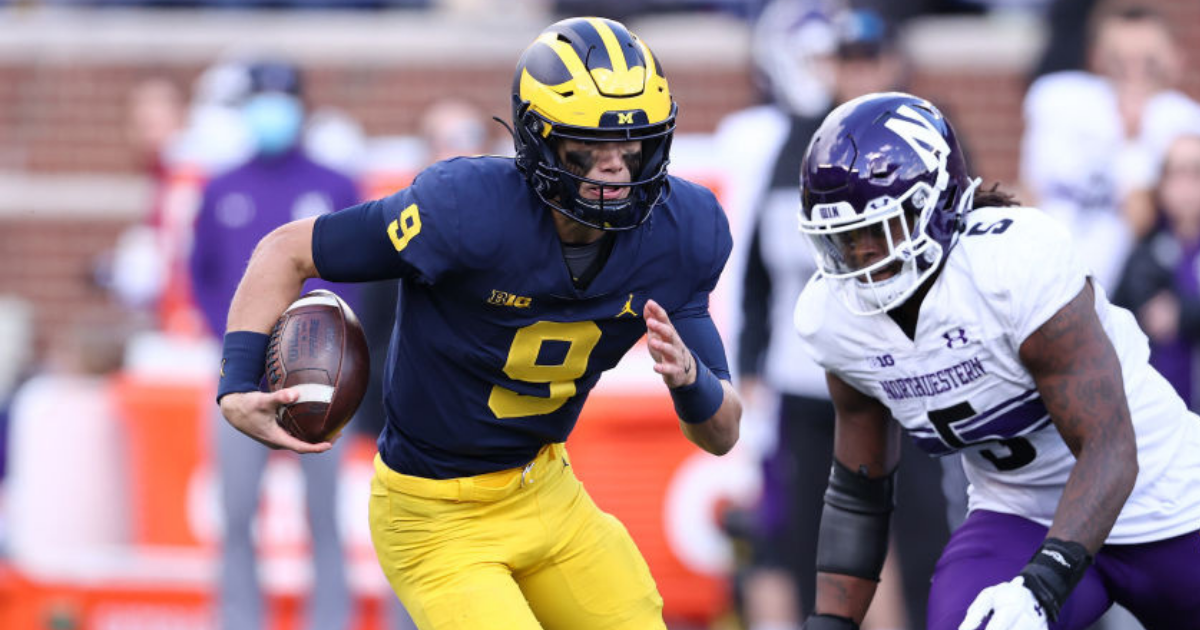JJ McCarthy’s Surgical History: Jj Mccarthy Surgery

JJ McCarthy, a prominent figure in the world of American football, has undergone several surgeries throughout his career. These procedures have had a significant impact on his athletic performance and career trajectory. Understanding his surgical history provides valuable insights into his journey as an athlete.
Timeline of JJ McCarthy’s Surgeries
The following timeline details the known surgeries JJ McCarthy has undergone, including the dates, types of procedures, and reasons for each surgery.
- 2021: McCarthy underwent surgery on his throwing shoulder, specifically addressing a torn labrum. This injury occurred during his sophomore season at the University of Michigan, hindering his ability to throw with full strength and accuracy. The surgery aimed to repair the torn labrum, restoring stability and functionality to his shoulder joint. The recovery process for a labrum tear typically involves a period of rest, physical therapy, and gradual return to athletic activity.
- 2022: McCarthy underwent another surgery, this time on his left knee, to address a meniscus tear. This injury occurred during his junior season at Michigan, impacting his mobility and ability to perform at his best. The surgery involved repairing the torn meniscus, aiming to restore stability and function to his knee joint. The recovery process for a meniscus tear typically involves a period of rest, physical therapy, and gradual return to athletic activity.
Impact of Surgeries on Athletic Performance and Career Trajectory
JJ McCarthy’s surgical history has undoubtedly impacted his athletic performance and career trajectory. The surgeries required significant periods of recovery, limiting his ability to train and compete at his full potential.
- 2021: The shoulder surgery, while necessary to restore functionality, caused him to miss several games during his sophomore season. However, he demonstrated remarkable resilience, returning to the field and contributing to Michigan’s success.
- 2022: The knee surgery also required a period of recovery, limiting his participation in the early stages of his junior season. Despite the setback, McCarthy demonstrated his determination, returning to the field and showcasing his talent.
Recovery Process and Complications
The recovery process for each surgery involved a period of rest, physical therapy, and gradual return to athletic activity. McCarthy’s dedication and commitment to rehabilitation enabled him to return to the field in a timely manner.
- 2021: Following his shoulder surgery, McCarthy diligently followed his rehabilitation program, gradually increasing his range of motion and strength. The recovery process was successful, allowing him to return to the field with improved stability and functionality.
- 2022: McCarthy’s recovery from the knee surgery followed a similar path. He worked closely with physical therapists to regain strength, mobility, and stability in his knee. The recovery process was successful, enabling him to return to the field and continue his athletic journey.
Common Surgical Procedures in Football Players

Football, a sport renowned for its physicality and intensity, inevitably leads to injuries. While some injuries heal naturally, others necessitate surgical intervention. This section delves into the most common surgical procedures performed on football players, exploring their causes, typical recovery times, and the associated risks and benefits.
Types of Surgeries, Jj mccarthy surgery
Surgical procedures in football players are often necessary to repair injuries sustained during gameplay. These procedures aim to restore function, stability, and pain relief. The most common types of surgeries include:
- ACL Reconstruction: The anterior cruciate ligament (ACL) is a crucial ligament in the knee, providing stability. An ACL tear is a common injury in football, often resulting from a sudden twisting or pivoting motion. ACL reconstruction involves replacing the torn ligament with a graft, typically taken from the patellar tendon, hamstring, or quadriceps tendon. Recovery typically takes 6-9 months, with a gradual return to activity.
- Meniscus Repair/Removal: The meniscus is a C-shaped cartilage that acts as a shock absorber in the knee. A meniscus tear can occur due to a direct impact or twisting motion. Repair is possible if the tear is small and located in a stable area. However, a partial or complete meniscectomy (removal) may be necessary for larger or unstable tears. Recovery time for meniscus repair can range from 4-6 weeks, while meniscectomy recovery takes 2-4 weeks.
- Shoulder Rotator Cuff Repair: The rotator cuff comprises four muscles and their tendons that stabilize the shoulder joint. A tear in the rotator cuff can occur due to overuse, repetitive motions, or direct trauma. Repair involves suturing the torn tendon back to the bone. Recovery time varies depending on the severity of the tear and can range from 3-6 months.
- Achilles Tendon Repair: The Achilles tendon is the thickest tendon in the body, connecting the calf muscles to the heel bone. A rupture or tear in the Achilles tendon can occur due to sudden forceful movements or a direct impact. Repair typically involves surgically reattaching the tendon to the heel bone. Recovery time is typically 4-6 months.
Risks and Benefits of Surgical Options
The decision to undergo surgery is a complex one, involving careful consideration of the risks and benefits.
- ACL Reconstruction:
- Benefits: Restoration of knee stability, allowing for a return to high-impact activities.
- Risks: Infection, blood clots, graft failure, continued pain, and stiffness.
- Meniscus Repair/Removal:
- Benefits: Reduced pain and improved knee function. Repair allows for preservation of the meniscus, while removal may be necessary for severe tears.
- Risks: Infection, pain, stiffness, and potential long-term instability.
- Shoulder Rotator Cuff Repair:
- Benefits: Restoration of shoulder strength and function, allowing for overhead activities.
- Risks: Infection, pain, stiffness, and potential nerve damage.
- Achilles Tendon Repair:
- Benefits: Restoration of ankle strength and function, allowing for walking and running.
- Risks: Infection, pain, stiffness, and potential nerve damage.
Common Football Injuries and Recovery Timelines
| Injury | Surgical Procedure | Typical Recovery Time |
|---|---|---|
| ACL Tear | ACL Reconstruction | 6-9 months |
| Meniscus Tear | Meniscus Repair/Removal | 4-6 weeks (repair), 2-4 weeks (removal) |
| Shoulder Rotator Cuff Tear | Rotator Cuff Repair | 3-6 months |
| Achilles Tendon Rupture | Achilles Tendon Repair | 4-6 months |
The Role of Surgery in Sports Medicine

Surgery plays a crucial role in treating sports-related injuries, offering a range of solutions for athletes seeking to return to their desired level of performance. While surgery is not always the answer, it can be a vital tool in addressing complex injuries and restoring function.
Advantages of Surgery in Sports Medicine
Surgical intervention can offer significant advantages for athletes facing certain types of injuries. Here are some key benefits:
- Restoration of Function: Surgery can repair damaged tissues, ligaments, tendons, and bones, allowing athletes to regain their full range of motion and strength.
- Improved Stability: Procedures like ligament reconstruction or tendon repair can enhance joint stability, reducing the risk of re-injury and promoting a faster return to activity.
- Pain Relief: Surgery can effectively alleviate pain caused by chronic injuries, improving an athlete’s quality of life and facilitating rehabilitation.
- Faster Recovery: In some cases, surgery can lead to a faster recovery compared to non-surgical approaches, allowing athletes to return to their sport more quickly.
Limitations of Surgery in Sports Medicine
While surgery can be beneficial, it’s important to acknowledge its limitations:
- Risk of Complications: Like any surgical procedure, there are inherent risks associated with surgery, including infection, bleeding, and complications related to anesthesia.
- Recovery Time: Surgical procedures often require a significant period of recovery, involving physical therapy, rehabilitation, and limitations on activity.
- Cost: Surgical interventions can be expensive, requiring consideration of insurance coverage and out-of-pocket expenses.
- Not Always Necessary: Not all sports injuries require surgery. Conservative treatments like physical therapy, medication, and rest may be sufficient for certain conditions.
Evolving Landscape of Surgical Techniques and Technologies
The field of sports medicine surgery is constantly evolving, with advancements in techniques and technologies leading to improved outcomes and faster recovery times.
- Minimally Invasive Surgery: Advancements in minimally invasive techniques, such as arthroscopy, have reduced the need for large incisions, leading to less pain, scarring, and faster recovery.
- Biologics: The use of biologics, including platelet-rich plasma (PRP) and stem cells, is gaining traction in sports medicine. These therapies aim to promote tissue regeneration and healing, potentially reducing the need for surgery in some cases.
- Robotic Surgery: Robotic-assisted surgery is increasingly being utilized in sports medicine, offering enhanced precision, control, and visualization during procedures.
- 3D Printing: 3D printing technology is being used to create personalized implants and surgical guides, tailoring procedures to individual patient anatomy.
Considerations for Athletes Deciding on Surgery
When considering surgery, athletes should carefully weigh the potential benefits and risks, consulting with a qualified sports medicine specialist. Here are key considerations:
- Nature and Severity of Injury: The type and severity of the injury will determine the most appropriate treatment plan, including whether surgery is necessary.
- Athlete’s Goals: The athlete’s goals and desired level of performance should be factored into the decision-making process.
- Potential Risks and Benefits: A thorough discussion of the potential risks and benefits of surgery is essential.
- Recovery Time and Rehabilitation: Athletes should understand the expected recovery time and the commitment required for rehabilitation.
- Cost and Insurance Coverage: The financial implications of surgery, including costs and insurance coverage, should be considered.
Jj mccarthy surgery – JJ McCarthy’s surgery recovery is a crucial factor in his ability to lead the Vikings offense this season. While we all hope for a swift and full recovery, the team’s success hinges on the strength of the roster across the board, and a thorough understanding of the vikings depth chart is essential.
With McCarthy sidelined, the Vikings will need to rely on the depth and experience of the other players to maintain a competitive edge.
JJ McCarthy’s surgery is a reminder of the fragility of athletic careers. While we pray for his speedy recovery, it’s also a time to celebrate the resilience of players like jahmyr gibbs , who continue to inspire us with their dedication and hard work.
Let’s continue to support JJ in his journey back to the field, and acknowledge the strength and determination of all athletes who face adversity with grace.
